Joint Reconstruction Devices Market Size
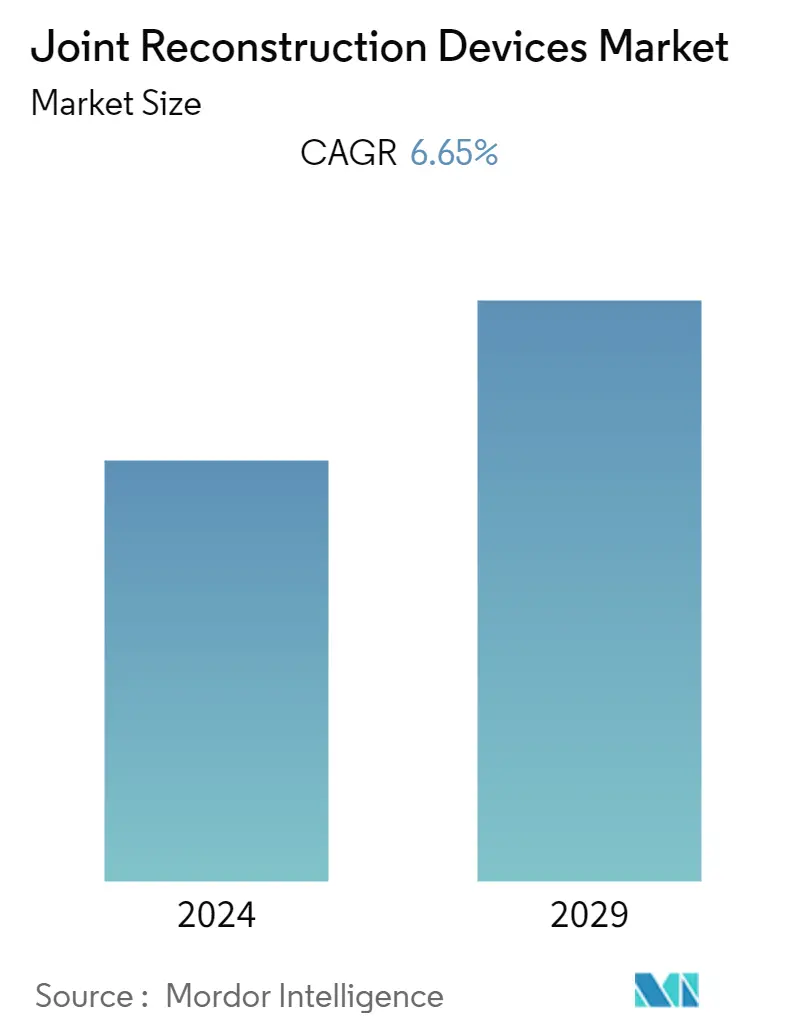
| Study Period | 2019 - 2029 |
| Base Year For Estimation | 2023 |
| Forecast Data Period | 2024 - 2029 |
| CAGR | 6.65 % |
| Fastest Growing Market | Asia Pacific |
| Largest Market | North America |
Major Players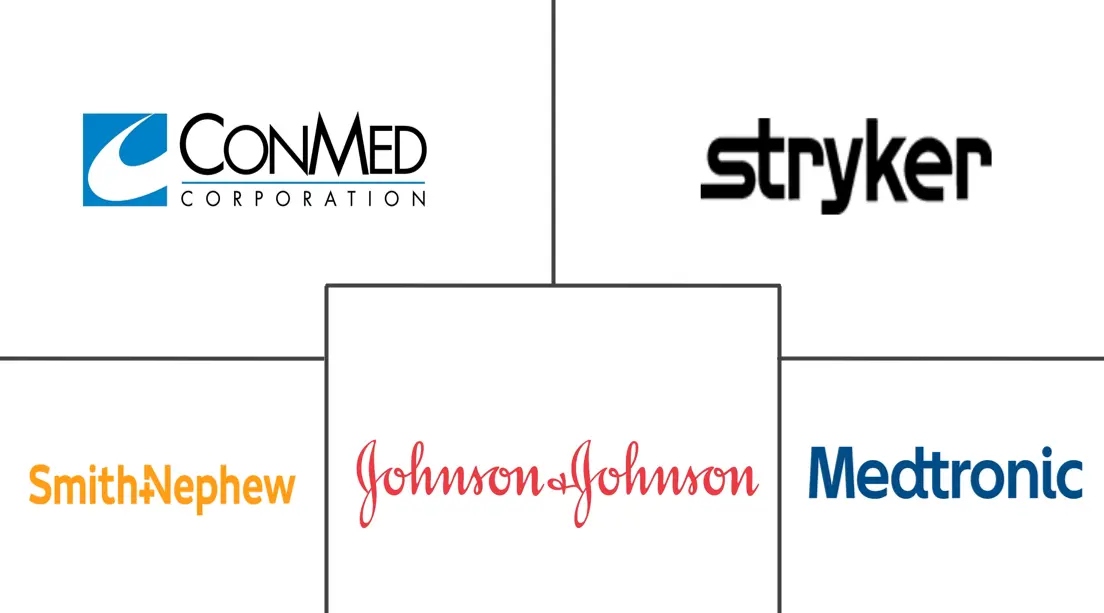
*Disclaimer: Major Players sorted in no particular order |
Joint Reconstruction Devices Market Analysis
The joint reconstruction devices market is expected to witness a CAGR of 6.55% during the forecast period.
COVID-19 had impacted the joint reconstruction devices market due to the cancellation of elective surgeries. For instance, an article published in J. Arthroplasty in April 2021 reported that the COVID-19 pandemic significantly affected arthroplasty practice. The article also reported the cancellation of many hip and knee arthroplasty services during the pandemic, which directly impacted the joint reconstruction devices market. Thus, initially, the market faced significant challenges due to the pandemic restrictions. However, with the ease of government regulations and the resumption of healthcare services the market witnessed significant growth.
The key factors propelling the growth of the market studied are the growing prevalence of orthopedic diseases, the increasing aging population, the increasing preference for minimally invasive techniques, and an increasing number of large joint reconstruction surgeries. With the growing prevalence of orthopedic diseases such as arthritis, osteoporosis, knee injuries, etc., resulting in damage to bones and serious cases, joint reconstruction surgery is the ultimate treatment available. For instance, in December 2021, Work-Related Musculoskeletal Disorders Statistics in Great Britain reported that 4,70,000 workers suffered from work-related musculoskeletal disorders (new or long-standing) in 2020/21. This represents 1,420 per 100,000 workers and thus accounts for 28% of all work-induced ill health.
Similarly, another article published by the journal PTJ in January 2021 reported that musculoskeletal conditions are the most common causes of disability and limitations related to daily living and gainful employment in the United States. Thus, a high number of musculoskeletal conditions, including knee, hip, and other joint conditions, increase the demand for joint replacement surgical procedures. This is propelling the market's growth.
As the geriatric population increases, the market studied is also expected to grow as weak bones are more likely to develop in the geriatric population. Joint-related disorders are more likely to arise in the geriatric population, resulting in the need for joint reconstruction surgery, thereby driving the market for joint reconstruction devices. For instance, an article published in the journal, J. Am. Acad. Orthop. Surg. in January 2022 reported a higher prevalence of joint pain among the older population. Thus, with increasing aging, individuals become more susceptible to orthopedic diseases, leading to increasing joint surgery, thereby driving the growth of the market studied.
Also, the introduction of minimally invasive surgery, which is associated with less pain, a shorter hospital stay, and fewer complications, and the increasing use of this surgical procedure are contributing to the growth of the joint replacement devices market. For instance, in May 2022, Premier Furey reported a new approach to address surgical backlogs for hip and knee replacement surgeries. Also, improved perioperative short-acting anesthesia, minimally invasive surgical techniques, and the initiation of rehabilitation protocols soon after surgery have made this surgery possible as an outpatient procedure. As a result, technological advancements are further propelling the growth of the market studied.
Furthermore, the increasing number of large joint reconstruction surgeries is also propelling the growth of the studied market. For instance, in November 2021, the AJRR, the cornerstone of the American Academy of Orthopaedic Surgeons in its 2021 Annual Report on hip and knee arthroplasty procedural trends, reported an overall cumulative procedural volume growth of 18.3% compared to the previous year, 2020. Thus, the increasing number of joint reconstruction surgeries is driving the growth of the market studied.
Thus, for the aforesaid reasons, the market is expected to witness significant growth during the forecast period. However, due to increased awareness about alternative treatments, stringent regulatory reforms and regulatory issues may hamper the growth of the market studied.
Joint Reconstruction Devices Market Trends
This section covers the major market trends shaping the Joint Reconstruction Devices Market according to our research experts:
Joint Replacement Devices Segment is Expected to Witness a Significant Growth Over the Forecast Period.
The joint replacement devices segment is expected to witness significant growth over the forecast period owing to the increase in the geriatric population, the increase in degenerative knee diseases, and technological developments.
The increasing number of joint replacement surgery occurring globally is contributing to the growth of this segment. For instance, an article published in the journal, J. Orthop. Surg. Res., in October 2022, reported a significant increase in the number of osteosynthesis implants and joint replacement implants in the past decade, and the demand for knee replacement in the United States is expected to increase by 673% by 2030. Thus, the high demand for joint replacement surgery is propelling the growth of this segment.
Similarly, the increasing geriatric population globally is also propelling the growth of this segment, as the geriatric population is more prevalent in joint surgeries and the increasing their increasing population is expected to drive the growth of the studied market. For instance, United Nations 2022, factsheet reported that in 2022, about 9.7% population in the world aged 65 and above, and this number is expected to increase by 16.4% by 2050. Thus, the high geriatric population is propelling the growth of this segment.
The safety and efficacy of medical devices and technological advancements such as product launches, mergers, acquisitions, and partnerships are propelling the growth of this segment. For instance, in July 2022, Enovis launched a wearable device for knee and hip replacement. The system is said to be the only proprietary, real-time, hands-free augmented reality (AR) technology that has been developed to provide orthopedic surgeons with precision guidance visualization while performing hip and knee surgery. Similarly, in April 2022, a joint replacement device CUVIS third generation active and fully automated joint replacement system in one of the hospitals in India. Thus, such technological advancements is driving the growth of the segment.
Thus, due to the aforesaid reasons, the segment is expected to witness a significant over the forecast period.
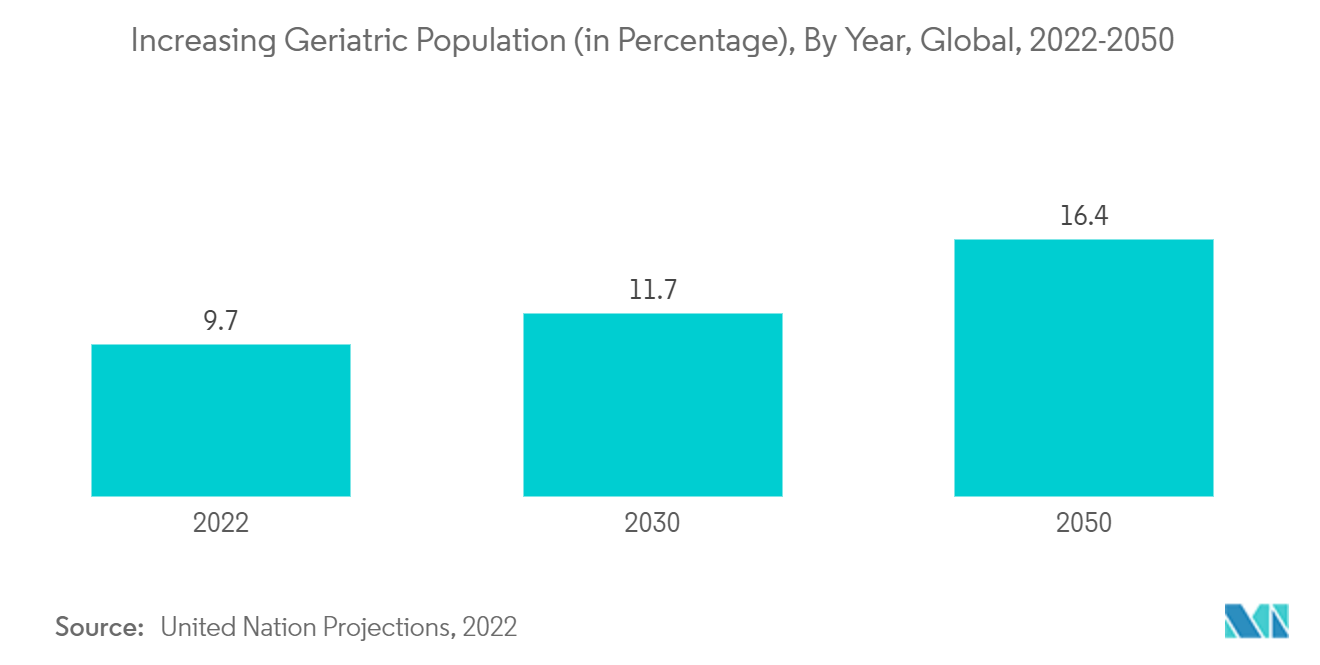
North America is Expected to Witness a Significant Growth Over the Forecast Period
North America is expected to witness significant growth during the forecast period due to the increasing number of surgeries, the rising aging population with increasing orthopedic conditions, and the preference toward minimally invasive procedures.
The increasing number of joint surgeries in the region is propelling the growth of this market in the region. For instance, an article published in Arthroplasty Today in February 2022 reported that the AJRR 2021 accounted for 2,244,587 primary and revision hip and knee arthroplasties in the last decade. Most of the surgeries were primary total knee arthroplasty (54.5%) and primary total hip arthroplasty (38.6%). Female patients represented 58.5% of all procedures, while male patients represented 38.6% of all cases. The article reported a significant increase in these surgeries as compared to previous years. A high percentage of the geriatric population undergoes these surgical procedures. Thus, a high number of joint replacement surgical procedures is driving the growth of this market in the region.
The other two North American countries, Canada and Mexico, are also propelling the growth of the market owing to the increase in the geriatric population and technological development. In April 2022, Statistics Canada reported that there were 7.3 million people aged 65 and older in the country. Also, the population aged 85 and older is one of the fastest-growing age groups, with a 12% increase in the last six years. Thus, an increasing geriatric population is associated with an increase in joint reconstruction surgery, thereby propelling the market studied in the region.
Technological advancements by key market players are propelling the growth of this market in the region. For instance, in October 2022, Orthofix and SeaSpine combined in a merger of equals to create a global spine and orthopedics company. The combined company will be a global spine and orthopedics company. It will have highly complementary portfolios of biologics, innovative spinal hardware, bone growth therapies, specialized orthopedic solutions, and a surgical navigation system.
Thus, due to the above-mentioned factors, the region is expected to witness significant growth during the forecast period.
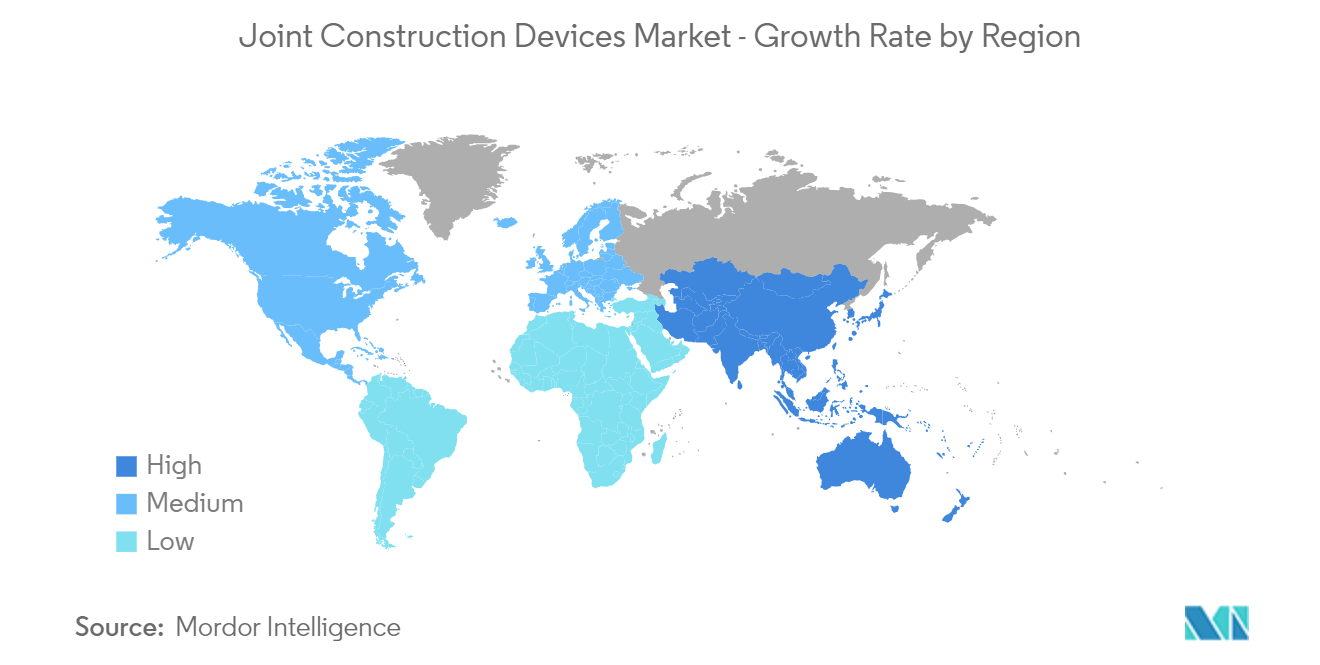
Joint Reconstruction Devices Industry Overview
The joint reconstruction devices market is fragmented and competitive due to the presence of many market players present regionally and globally such as B. Braun GmbH (Aesculap Implant Systems LLC), Conmed Corporation, Johnson and Johnson (DePuy Synthes Inc.), Donjoy Inc. Supply and Services Inc., Medtronic Inc., Nuvasive Inc., Smith & Nephew PLC, Stryker Corporation, Wright Medical Technology Inc., Zimmer Biomet Holdings Inc., AAP Implantate AG, Allegra Orthopaedics Limited, and Alphatec Spine Inc.
Joint Reconstruction Devices Market Leaders
-
Conmed Corporation
-
Medtronic PLC
-
Smith & Nephew PLC
-
Stryker Corporation
-
Johnson and Johnson (DePuy Synthes, Inc.)
*Disclaimer: Major Players sorted in no particular order
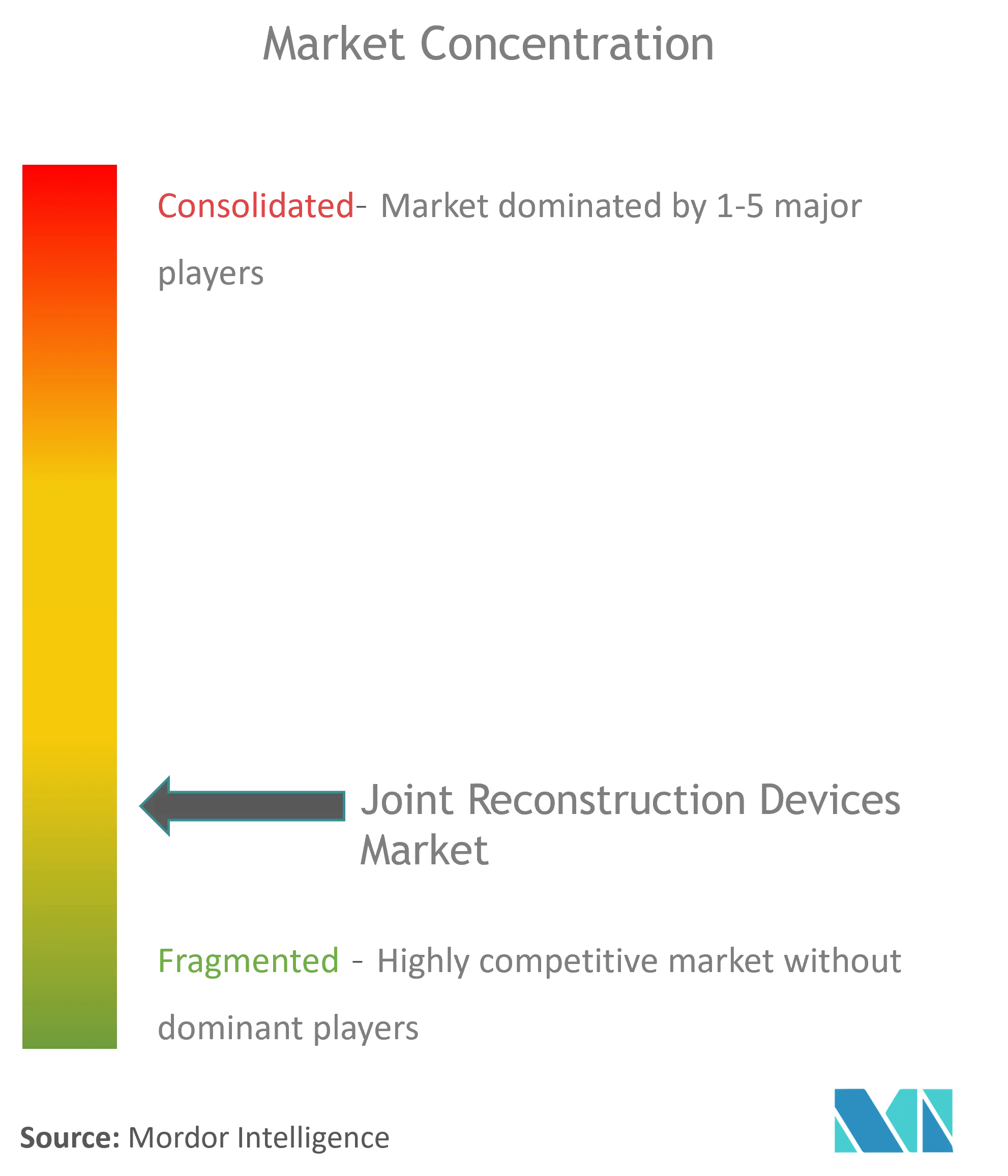
Joint Reconstruction Devices Market News
- October 2022: LimaCorporate received USFDA approval for a new shoulder platform focused on the glenoid baseplate and the humeral stem is fully 3D-printed. Using the patented Trabecular Titanium (TT) technology, this dental implant system aims to achieve strong primary fixation and successful secondary bone ingrowth.
- September 2022: Smith & Nephew PLC launched its OR3O dual mobility system for use in primary and revision hip arthroplasty in Japan.
Joint Reconstruction Devices Market Report - Table of Contents
1. INTRODUCTION
- 1.1 Study Assumptions and Market Definition
- 1.2 Scope of the Study
2. RESEARCH METHODOLOGY
3. EXECUTIVE SUMMARY
4. MARKET DYNAMICS
- 4.1 Market Overview
-
4.2 Market Drivers
- 4.2.1 Growing Prevalence of Orthopedic Diseases
- 4.2.2 Increasing Aging Population
- 4.2.3 Increasing Preference for Minimally Invasive Techniques
- 4.2.4 Increasing Number of Large Joint Reconstruction Surgeries
-
4.3 Market Restraints
- 4.3.1 Increase Awareness about Alternative Treatments
- 4.3.2 Stringent Regulatory Reforms
- 4.3.3 Regulatory Issues
-
4.4 Porter's Five Force Analysis
- 4.4.1 Threat of New Entrants
- 4.4.2 Bargaining Power of Buyers/Consumers
- 4.4.3 Bargaining Power of Suppliers
- 4.4.4 Threat of Substitute Products
- 4.4.5 Intensity of Competitive Rivalry
5. MARKET SEGMENTATION (Market Size by Value - USD million)
-
5.1 By Device Type
- 5.1.1 Joint Replacement Devices
- 5.1.2 Osteotomy Devices
- 5.1.3 Arthroscopy Devices
- 5.1.4 Resurfacing Devices
- 5.1.5 Arthrodesis Devices
- 5.1.6 Other Device Types
-
5.2 By Joint Type
- 5.2.1 Knee
- 5.2.2 Hip
- 5.2.3 Shoulder
- 5.2.4 Ankle
- 5.2.5 Other Joint Types
-
5.3 Geography
- 5.3.1 North America
- 5.3.1.1 United States
- 5.3.1.2 Canada
- 5.3.1.3 Mexico
- 5.3.2 Europe
- 5.3.2.1 Germany
- 5.3.2.2 United Kingdom
- 5.3.2.3 France
- 5.3.2.4 Italy
- 5.3.2.5 Spain
- 5.3.2.6 Rest of Europe
- 5.3.3 Asia-Pacific
- 5.3.3.1 China
- 5.3.3.2 Japan
- 5.3.3.3 India
- 5.3.3.4 Australia
- 5.3.3.5 South Korea
- 5.3.3.6 Rest of Asia-Pacific
- 5.3.4 Middle East and Africa
- 5.3.4.1 GCC
- 5.3.4.2 South Africa
- 5.3.4.3 Rest of Middle East and Africa
- 5.3.5 South America
- 5.3.5.1 Brazil
- 5.3.5.2 Argentina
- 5.3.5.3 Rest of South America
6. COMPETITIVE LANDSCAPE
-
6.1 Company Profiles
- 6.1.1 B. Braun GmbH (Aesculap Implant Systems LLC)
- 6.1.2 Conmed Corporation
- 6.1.3 Johnson and Johnson (DePuy Synthes Inc.)
- 6.1.4 Donjoy Inc. Supply and Services Inc.
- 6.1.5 Medtronic Inc.
- 6.1.6 Nuvasive Inc.
- 6.1.7 Smith & Nephew PLC
- 6.1.8 Stryker Corporation
- 6.1.9 Wright Medical Technology Inc.
- 6.1.10 Zimmer Biomet Holdings Inc.
- 6.1.11 AAP Implantate AG
- 6.1.12 Allegra Orthopaedics Limited
- 6.1.13 Alphatec Spine Inc.
- *List Not Exhaustive
7. MARKET OPPORTUNITIES AND FUTURE TRENDS
** Subject To AvailablityJoint Reconstruction Devices Industry Segmentation
Joint reconstruction devices are used in procedures used to repair or replace joint bones. Joint reconstruction is considered a treatment when severe joint pain or dysfunction occurs. It is often indicated by various joint diseases, including osteoarthritis and rheumatoid arthritis.
The joint reconstruction devices market is segmented by device type (joint replacement devices, osteotomy devices, arthroscopy devices, resurfacing devices, arthrodesis devices, and other device types), joint type (knee, hip, shoulder, ankle, and other joint types), and geography (North America, Europe, Asia-Pacific, Middle East, and Africa, and South America). The market report also covers estimated market sizes and trends for 17 countries across major regions globally. The report offers the value (in USD million) for the above segments.
| By Device Type | Joint Replacement Devices | |
| Osteotomy Devices | ||
| Arthroscopy Devices | ||
| Resurfacing Devices | ||
| Arthrodesis Devices | ||
| Other Device Types | ||
| By Joint Type | Knee | |
| Hip | ||
| Shoulder | ||
| Ankle | ||
| Other Joint Types | ||
| Geography | North America | United States |
| Canada | ||
| Mexico | ||
| Geography | Europe | Germany |
| United Kingdom | ||
| France | ||
| Italy | ||
| Spain | ||
| Rest of Europe | ||
| Geography | Asia-Pacific | China |
| Japan | ||
| India | ||
| Australia | ||
| South Korea | ||
| Rest of Asia-Pacific | ||
| Geography | Middle East and Africa | GCC |
| South Africa | ||
| Rest of Middle East and Africa | ||
| Geography | South America | Brazil |
| Argentina | ||
| Rest of South America |
Joint Reconstruction Devices Market Research FAQs
What is the current Joint Reconstruction Devices Market size?
The Joint Reconstruction Devices Market is projected to register a CAGR of 6.65% during the forecast period (2024-2029)
Who are the key players in Joint Reconstruction Devices Market?
Conmed Corporation, Medtronic PLC, Smith & Nephew PLC, Stryker Corporation and Johnson and Johnson (DePuy Synthes, Inc.) are the major companies operating in the Joint Reconstruction Devices Market.
Which is the fastest growing region in Joint Reconstruction Devices Market?
Asia Pacific is estimated to grow at the highest CAGR over the forecast period (2024-2029).
Which region has the biggest share in Joint Reconstruction Devices Market?
In 2024, the North America accounts for the largest market share in Joint Reconstruction Devices Market.
What years does this Joint Reconstruction Devices Market cover?
The report covers the Joint Reconstruction Devices Market historical market size for years: 2019, 2020, 2021, 2022 and 2023. The report also forecasts the Joint Reconstruction Devices Market size for years: 2024, 2025, 2026, 2027, 2028 and 2029.
Joint Reconstruction Devices Industry Report
Statistics for the 2024 Joint Reconstruction Devices market share, size and revenue growth rate, created by Mordor Intelligence™ Industry Reports. Joint Reconstruction Devices analysis includes a market forecast outlook to 2029 and historical overview. Get a sample of this industry analysis as a free report PDF download.



